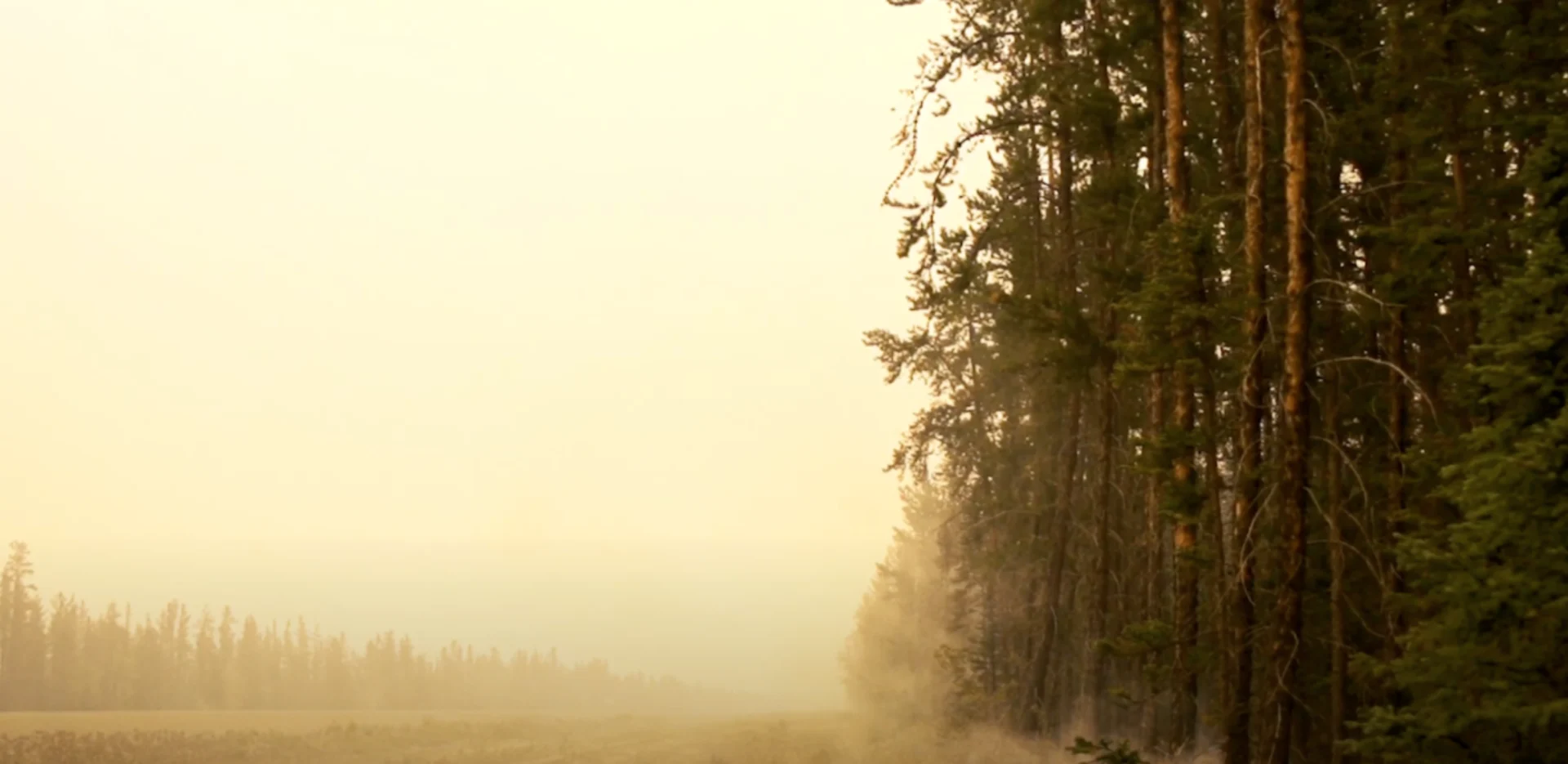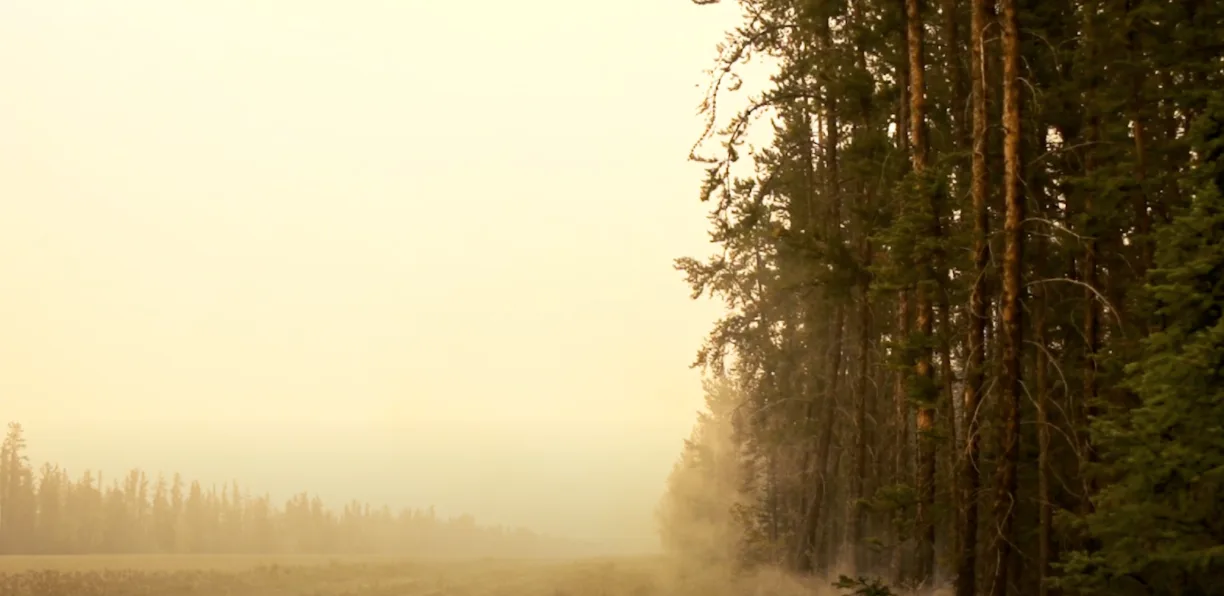
Canada faces a smokier future, and health systems need to prepare: Report
A new report into the rising health toll of longer and more intense wildfire seasons warns Canadian governments to take preparations seriously.
In Yellowknife, most summers, you can just about see for miles when looking out over the white-capped waters of Great Slave Lake. For emergency department physician Dr. Courtney Howard, it was a regular and welcome sight.
Seven years ago, however, it was a different story. The Northwest Territories spent much of that summer shrouded in the smoke from 385 wildfires, burning an astounding 3.4 million hectares of land. The sprawling expanse of the lake, one of Canada’s largest, nearly vanished from the sight of Yellowknife’s 20,000 residents.
“It got to the moment where we would almost make a game of guessing what the air quality health index was, based on how far we could see. And we got good at it, because we had two and a half months to practice,” Howard told The Weather Network. “We had essentially so many wildfires surrounding Yellowknife that no matter which way the wind was blowing, most days it would be blowing smoke toward us.”
Two and a half months is a long time to be breathing in wildfire smoke. As a physician, Howard was on the front line of the impact on the health of the city’s residents, and saw firsthand the sharp and sustained rise in breathing-related illnesses in the people filling her emergency department, and noted how much harder they were to stabilize with the usual medications. She recalled one day where, for the first four hours, every visitor had asthma.

The summer of 2014 saw wildfire smoke shroud much of the Northwest Territories for two and a half months. (Government of the Northwest Territories).
Howard later channelled her experiences into a study that found asthma cases doubled during the course of the event, and prescriptions of particular kinds of medications jumped by half. Every 10-microgram increase in the smaller kind of smoke particles, PM2.5, drove a rise in ER visits of 11 per cent for asthma, 6 per cent for pneumonia, and 11 per cent for chronic obstructive pulmonary disease (COPD).
Aside from the medical toll, Howard stressed the mental health impact. With air quality often too dangerous to go outside, people were kept from the kind of outdoor activities, like gardening in town or hiking in the woods, that are essential to making the most of the short-lived Arctic summer.
“Over two and a half months, people went absolutely stir crazy. It was sort of like COVID, except you couldn’t go outside,” she said. “We were all just irritable.”
In 2014, it all must have felt unprecedented. Now, in the midst of a summer of nation-wide smoke from numerous wildfires, including one fire that destroyed the B.C. village of Lytton, it looks like the first chapter of a difficult future.
There’ve been a number of studies looking at the expected public health impacts of climate change, which in Canada is expected to impact millions of people and cost billions of dollars in healthcare costs and lost productivity.
In June, the Global Climate and Health Alliance released its own report, which included Howard’s work into the multi-national health impacts of wildfire smoke in a world where climate change is making wildfires worse, more numerous, and longer-lived. Entitled “The Limits of Livability,” the report stresses that worsening wildfires will have detrimental health impacts — not only breathing-related illness, but also mental health impacts from prolonged smoke emergencies, as well as the traumas of evacuation and loss of property.
From 1980-2017, the report says, some 448,444 people in Canada were forced to evacuate due to wildfires, half of them in the last decade. The most dramatic example was in Fort McMurray, where a 2016 wildfire destroyed part of the city and sent 88,000 people fleeing north and south. Under mid-range emissions scenarios, wildfires in Canada could increase by 75 percent by the year 2100.
The report’s authors say, bluntly, that public health infrastructure is “not currently equipped to deal with longer wildfire events,” and that beyond the need to curb emissions, climate change adaptation measures need to consciously include strengthening healthcare systems, which includes preparing for longer-term smoke events.
“The short term health effects of forest smoke are now well documented but the long term effects of extended exposure are unknown. It is clear that there are significant research gaps in understanding the full health impacts of smoke from increased wildfire risk in a warming world, and on primary and secondary health services”, the report’s lead author, Dr. Frances MacGuire, said in a release.
WATCH BELOW: FIVE WAYS CLIMATE CHANGE WILL IMPACT PEOPLE'S HEALTH
The report has a number of recommendations, including revising the pan-Canadian emergency response to account for future climate change projections, developing easy-to-use emergency plans for residents and communities, and account for vulnerable populations most likely to struggle with smoke exposure, such as Indigenous people living in remote areas.
“Reducing smoke emissions from wildfires will benefit both human health and climate change since most of the air pollutants from fire smoke overlap with the pollutants that cause climate change,” the report adds.
With her experience in Yellowknife in mind, Howard adds part of strengthening healthcare systems will be to integrate climate change, and its health impacts, into medical school curriculums, to prepare physicians for what’s to come.
“They’re graduating from Canadian medical schools having had zero training on climate change and health,” she said. “So because our health workers are not briefed, they are not helping increase awareness of the need to make sure that our healthcare systems are prepared for the climate impacts we’re already seeing, and the ones we predict and we know will worsen in the future.”
And one crucial step in adapting to the new reality, Howard says, is taking the time to come to terms with the crisis on an emotional level. Beyond just simple self-care, she says, that process will strengthen people’s will to endure it.
“Right now, because it’s such disturbing information, I think, as a society, we have some collective emotional work to do,” she said, adding, “And that will put us in a place where the strategy that we then come up with together will be much, much, much more thought out.”
Follow Daniel Martins on Twitter @DFLCMartins

